MSI X99S MPower Review: Sting Like a Bee
by Ian Cutress on February 17, 2015 9:00 AM EST- Posted in
- Motherboards
- Intel
- MSI
- Overclocking
- X99
MSI X99S MPower BIOS
Very few changes from our last MSI X99 BIOS overview are present in the X99S MPower, and thus for completeness our analysis is included here with minor changes to represent the differences for MSI's OC Certified range.
The basic outline of the MSI BIOS has not changed that much since the introduction of the graphical BIOS however its implementation has significantly improved. We do not get much more over MSI’s Z97 series - only those options related to X99 are added. The layout is such that a persistent top ribbon is present indicating the motherboard being used, the BIOS version, the CPU installed, the CPU frequency, the memory size, the memory speed and the system temperatures. There is perhaps some whitespace here for some fan speeds as well. (Ignore the CPU temperature listed - I started taking these images without my CPU fan attached and the system eventually overheated. After spending 10 minutes wondering what the problem was, then facepalming, the temperature settled for the last few images. No damage was caused by the overheating as the automatic shut off worked great.)
Note that we don’t have the XMP button similar to Z97. This is because when using a kit without an XMP profile, the button disappears, but it is present on X99 when the appropriate kit is used. I would rather MSI still had the button present, but it was greyed out to indicate it was unavailable.
MSI’s system splits the BIOS up into two main areas – Settings and Overclocking. The Settings menu again subdivides into the System Status, Advanced, Boot, Security and Save & Exit.
For users wanting to adjust the PCIe bandwidth or disable the extra controllers, the Advanced menu gives all these options in separate sub-menus.
For example, in the PCIe Subsystem menu, the M.2 slot can be configured for both PCIe M.2 and SATA M.2 drives.
The Peripheral menu has the Hot Plug options for all the SATA ports. As with the other motherboards, the SATA ports are RAID capable but the sSATA are not, due to two AHCI controllers being present in the PCH with different functions. Unfortunately MSI does not distinguish here which ports are RAID capable and which are not – for reference SATA ports 1-6 allow RAID 0/1/5/10.
The other item of note in the Settings tab is that the user can issue a one-time boot override to a storage device of their choice:
The OC Menu is almost identical to Z97, allowing both a simple mode and an advanced mode:
Thankfully MSI has decided to keep the new arrangement of overclocking options, starting with CPU/BCLK, DRAM, Voltage and then others:
Advanced mode opens up a larger selection of options for experienced overclockers who are used to them. Users can also select when an enhanced BCLK overclock is applied (either before POST or after), and the Mem Try It option provides a couple of options for attempting to tighten up memory timings. As this is the overclocking model of the range, features such as advanced memory OC options for users with special or rare kits are provided:
The DRAM options allow for control over the sub-timings, and it is good to see that the current timings are shown alongside the option to adjust them.
Unfortunately the Load Line Calibration issue with MSI motherboards rears its head again. Under the digital power menu, it gives an option for CPU VDroop Offset, and allows the user to set ‘Auto, +12.5% - 100%’, but does not inform the user which way around it should be for a constant voltage response. Other motherboard manufacturers have this option sorted by either providing a graph or renaming the options to ‘Auto, Low, Medium, High, Turbo, Extreme’. MSI could learn a trick or two in this instance.
The OC menu also allows users to see the SPD information of the DRAM and adjust various aspects of the CPU features:
Alongside the Settings and OC tabs, the BIOS offers the M-Flash tool to update to the latest BIOS, overclocking profiles that can be saved and reloaded, a favorites menu for users to assign options they are used to (although not particularly needed with the new aligned OC menu) and also adjust the entry point of the BIOS.
The Hardware Monitor tab gives the fan options, which in recent generations has been substantially upgraded to some of the best we have ever seen.
When the Graphical BIOS nomenclature was introduced, the ‘graphical’ part was designed to help the user experience and interactivity with what are normally mundane options. The fan controls are a perfect example – a user should be able to see a multipoint gradient graph and adjust it using the mouse, rather than fiddling with menu options. MSI’s graph adjustments are not as finely grained as some other manufacturers, but the user experience is right on the money. MSI now needs to introduce some internal testing functionality so that the system can test the fan and adjust the scale on the graph appropriately for the fan response.
Similar to ASRock, we also get the Board Explorer functionality which allows the user to see what is installed. This is also useful if one stick of memory is not being seen or a PCIe device is not detected.


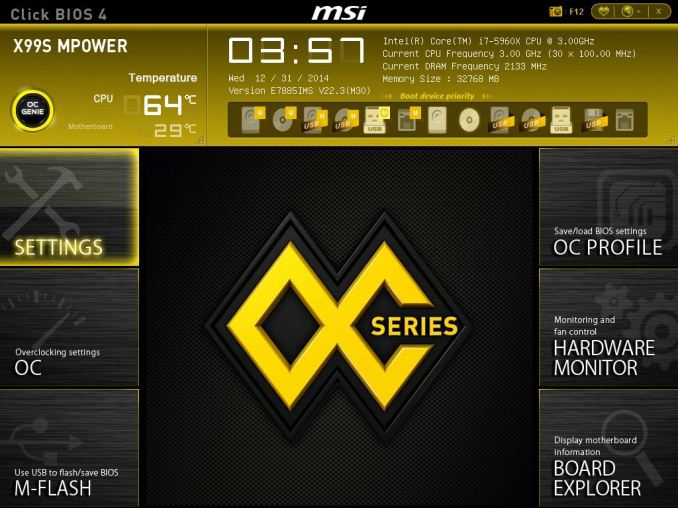
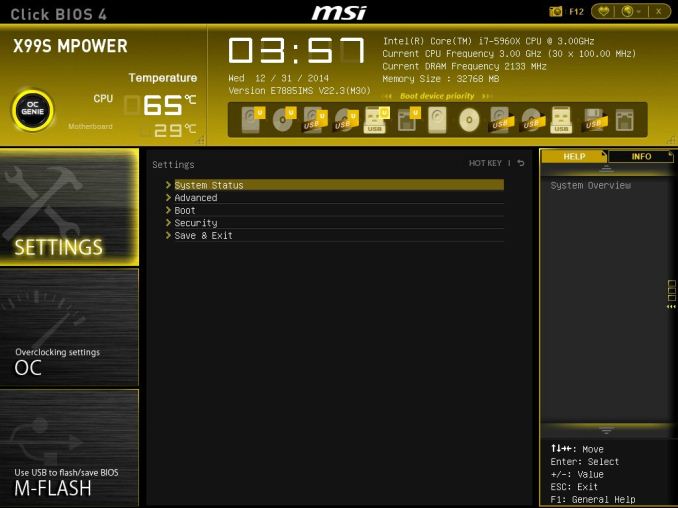
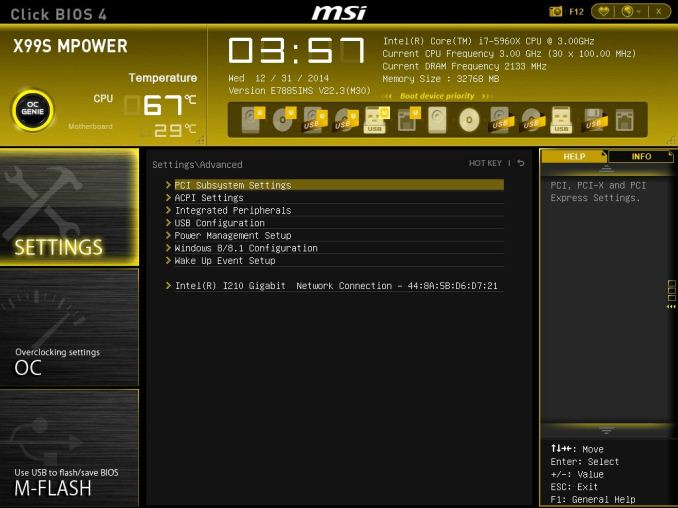
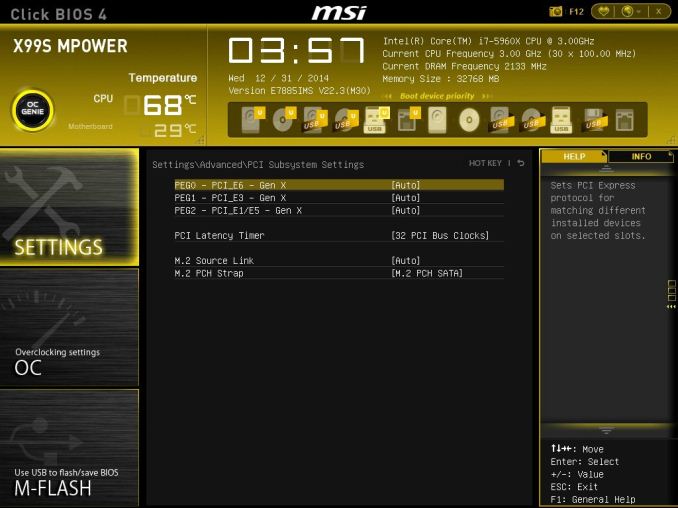
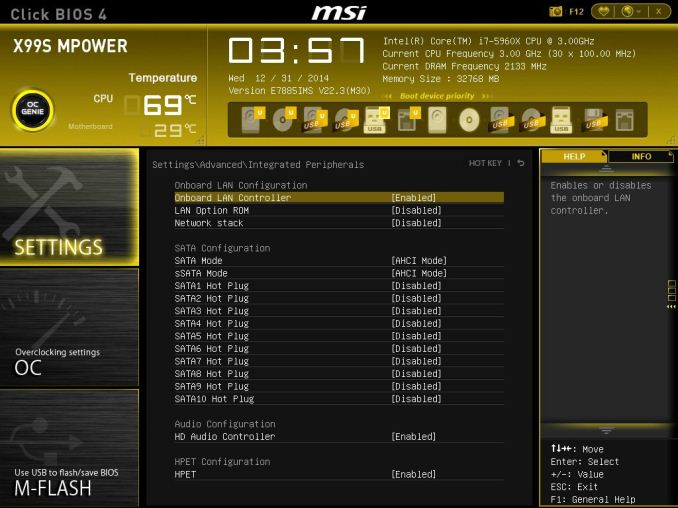
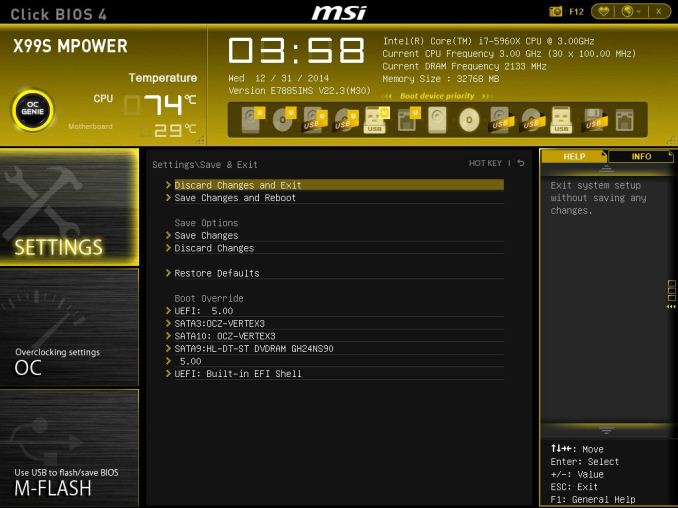
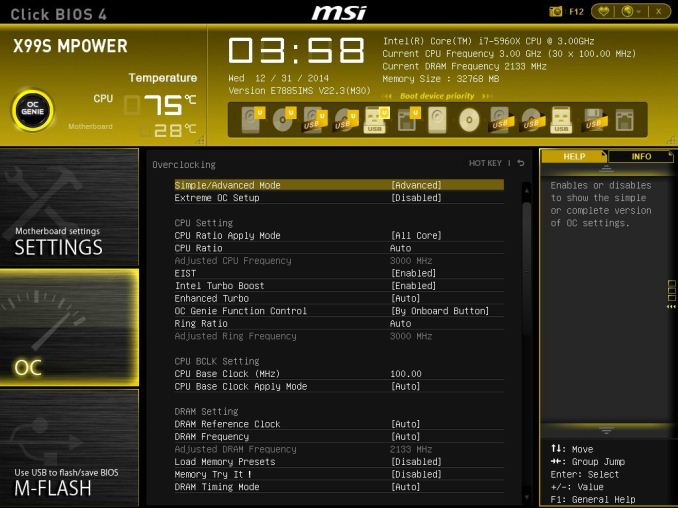
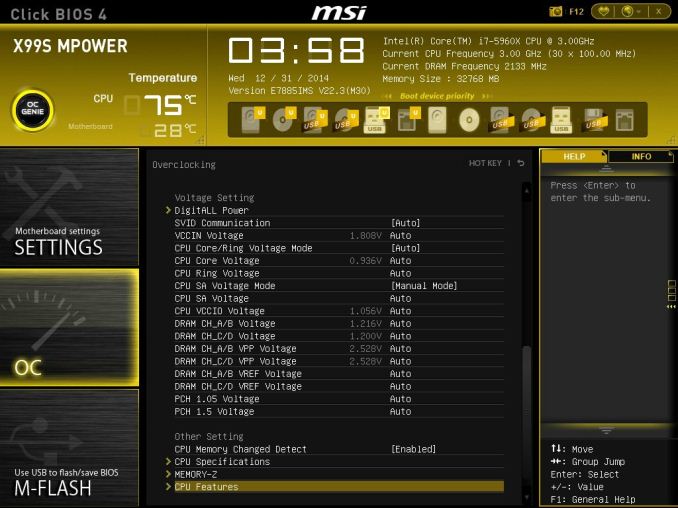
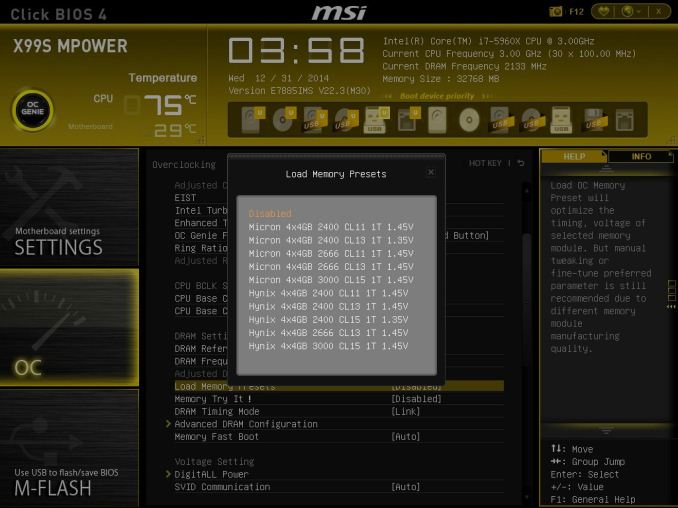
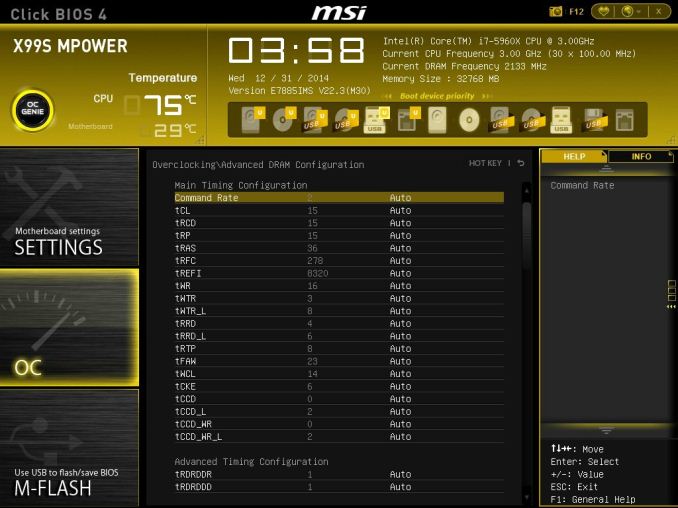

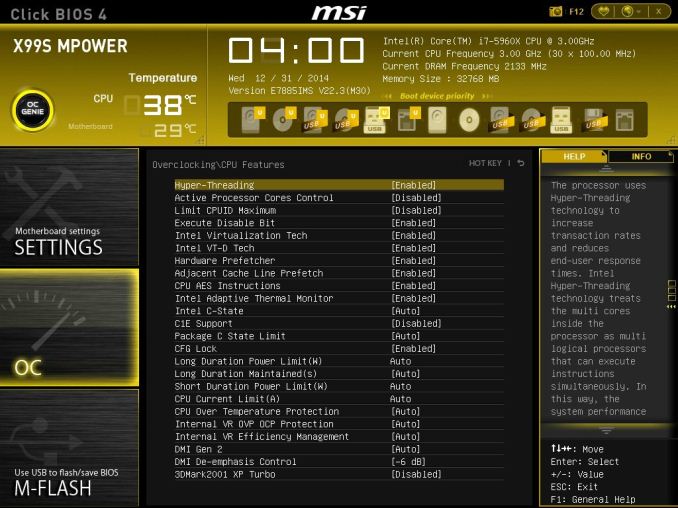
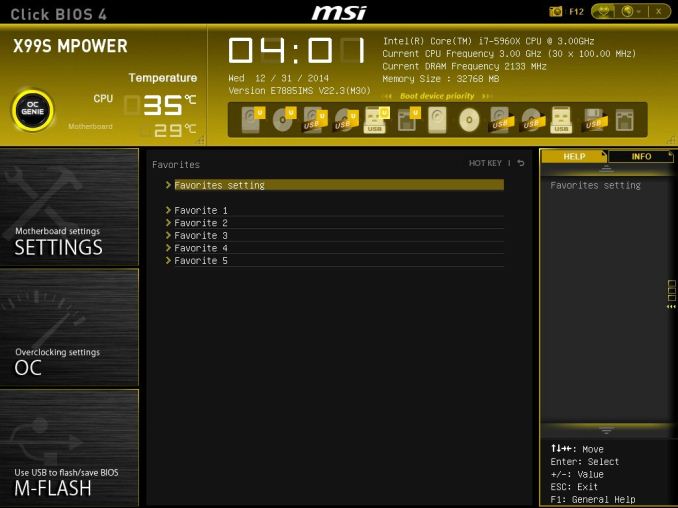
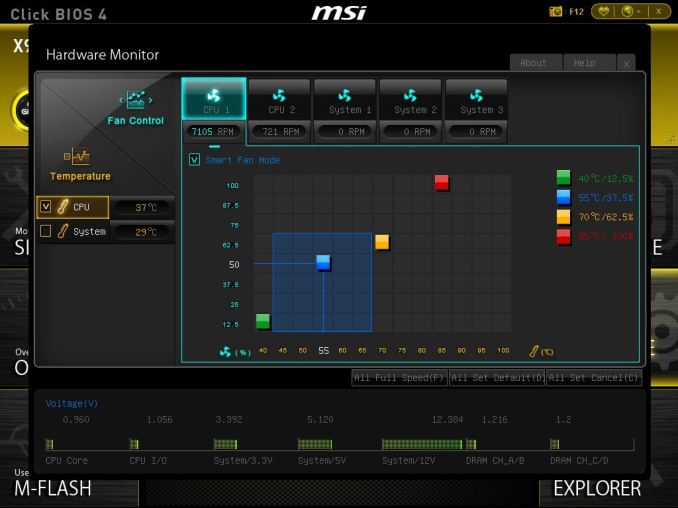
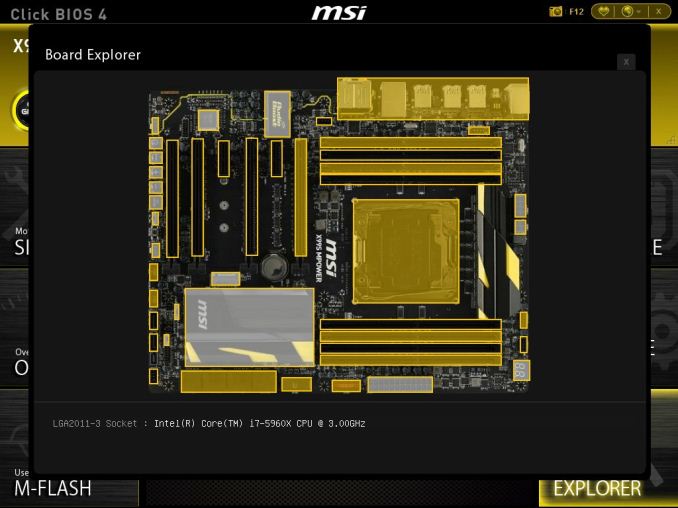














12 Comments
View All Comments
Horza - Tuesday, February 17, 2015 - link
Thanks for the review but no info regarding the power delivery? It's the first thing I look into with an overclocking board. More for reliability than any extra clock speed. I'm aware phase count is not always a useful metric but it would be nice to include it.Anyway it's 12 phase a "ISL6388 6-phase PWM" with doublers. "Fairchild FDMF5823DC MOSEFTs" rated 55a. Twelve Solid Ferrite Chokes (SFC). Memory is "Two Powervation PV3203 controllers"
tabascosauz - Tuesday, February 17, 2015 - link
Every manufacturer appears to be cheapening their boards that carry over from Z87 to Z97, but on X99, this is quite disappointing to hear. IR3550s are expensive, but an analog PWM on an overclocking board? This is a surprising choice, especially in the light of Asus' and GB's X99 boards. The X99 Deluxe pairs the nice "Blackwing" chokes with IR3550Ms, although it costs way more. Even the UD7, a non-OC geared board, comes in at just $20 more with the usual GB fare: all new IR, from the IR3580 PWM to the IR3556s.The ISL6388 is disappointing. This doesn't belong on MPower. So what if the FDMF5823 is one of Fairchild's DrMOS top-of-the-line products? The ISL6388 is on a completely different level. MSI has always flaunted their "Solid Ferrite Chokes" while hiding crappy MOSFETs/PWMs under heatsinks since Z77.
Antronman - Tuesday, February 17, 2015 - link
In the end, the serious OC purchase will always be ASUS' Rampage Extreme series. I don't understand why you'd cheapen your overclock with a board that has cut high-end features to lower the cost on the most expensive consumer platform.KennyDude27 - Wednesday, March 4, 2015 - link
Actually analog PWM or digital PWM doesn't mean one is better than the either. An analog pwm can be just as good if not better than a digital pwm and these days digital and analog is so obscure.If you mean digital control loop vs analog loop its hard to tell which is totally better. As long as the control loop is making the right decisions in the right amount of time it doesn't matter if its digital or analog. Phase shedding or increasing can be done in analog or digital as long as its done. Digital control loops do offer non linear control so you can do things such as have smaller caps but analog interfaced with digital can do the same and at much less power usage. The one issue with digital control is the process time so your limited to how fast the clock can run. Thats why they use alot of phases, it makes it so that the slow digital loop can handle it by dividing the time by the number of phases so you might be using a board that has more phases not for you but to help the digital control loop out since digital loop requires processing time to do its computation and control. So as switching speeds increase digital control may have a harder time while analog pwm can go to 20mhz or more no problem.
In the end its whichever solution gives the best performance and features people are willing to pay for
DanNeely - Tuesday, February 17, 2015 - link
I'm mildly surprised that MSI decided that this board could make due with only 2 12V connectors. The Z97 MPower used 3: 8pin, 4 pin, and 6pin PCIe; but its CPUs are lower power and is maxes out at 3GPUs vs potentially 4 here (with water cooling and if you can remove the video out ports on one card).29a - Tuesday, February 17, 2015 - link
What does 3DMark2001 XP Turbo in the BIOS do?Horza - Tuesday, February 17, 2015 - link
Boosts 3DMark2001 scores I'd imagine. My Gigabyte board has a similar "Legacy Benchmark Enhancement" setting in the bios which apparently boosts 01 score and SuperPi.kmmatney - Tuesday, February 17, 2015 - link
I just don't get why anyone spends $250+ on a motherboard. I've always been able to overclock my cpus quite high (better than the average, let's say) using motherboards that are virtually free with a Microcenter CPU+MB bundle. The last few motherboards have been the MSI PC-Mate Z77, and I was able to overclock both a G3258 and a Devil's Canyon Core i5 to levels on par with the Anandtech review of those respective cpus. The cpu heatsink makes more of a difference than the motherboard. I haven't had any stability problems overclocking, going back over 10 years, with basic motherboards. Once you have a good overclock and stability, what more do you need?Zap - Wednesday, February 18, 2015 - link
You can't directly compare pricing of socket 2011 motherboards versus socket 1150 motherboards. They are entirely different beasts.As for the exact same platform, more money gives more features. Also, some people can afford to spend more, and enjoy owning a "premium" product.
Why does someone pay for an iPhone when they can use a "almost the same" $100 Android phone? Why does someone pay for a top end Mercedes when a loaded Camry for $30,000 has power and leather everything, plus electronic gadgets?
That said, I do agree with you to a point. Sometimes more cost means real benefits. However, sometimes that just means extra NICs and PCIe slots and fancy VRM heatsinks that you still won't use or benefit from.
nos024 - Wednesday, February 18, 2015 - link
Choosing a motherboard is important, not just for overclocking capabilities. Whether you'd want SLI, extra USBs and SATA connectors, NIC, Wifi etc, Also some would like PCI/PS2 ports to carry on perips they want to incorporate into their new build. I learned this from many builds I'd built for myself. Essentially you are stuck with the motherboard you go with. I don't totally disagree with your point, but I've learned that cheap motherboards are just that...cheap.The most I will spend on a motherboard is $200 and I am quite satisfied with my ASRock Z97 Extreme 6. It took me months of research to settle on this. I'd happily pay an extra $50-100 for something I want.